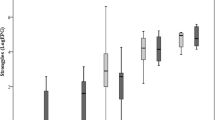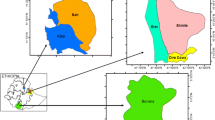Abstract
Tropical goat breeds often have at least modest resistance to gastrointestinal nematode parasites (GIN), but enhancement of GIN resistance is important for breed improvement. This study compared changes in fecal egg count (FEC), packed cell volume, and body weight in Red Sokoto (RS) and Sahelian (SH) male and female weaner kids and adult goats. The RS is found throughout Nigeria, but the SH is found only in the arid Sahel. Goats were evaluated fortnightly for 20 times (MT) under normal grazing conditions and natural GIN infection over 9.5 months, beginning in the dry season (November) and ending at the end of the subsequent wet season (August). Animals were dewormed at the start of the study and during the rainy season (MT 18). Breed differences in FEC and PCV were not observed in weaners. Weaner females had lower FEC than males but were rapidly re-infected after deworming, perhaps in association with attainment of puberty. Adult SH goats of both sexes had lower FEC than RS goats in MT 8 through 17, suggesting a stronger acquired immune response. The FEC in lactating females of both breeds increased rapidly after deworming, to ≥ 3000 eggs per gram of feces at MT 19 and 20. The optimal time to evaluate GIN resistance in weaners was during the early rainy season, but the decision to focus on the initial high FEC near MT 15 or wait until mobilization of the acquired immune response near MT 17 requires further consideration.








Similar content being viewed by others
Availability of data and materials
Data used in this article are available from the authors upon reasonable request.
Code availability
Not applicable.
References
Agossou, D.J., Dougba, T.D., Koluma, N., 2017. Recent development in goat farming and perspectives for sustainable production in Western Africa, International Journal of Agriculture Environment & Biotechnology, 2, 2047-2051.
Ajayi, F.O., Agaviezor, B.O., Vilawa, G., 2016. Genetic diversity of three Nigerian indigenous goats (Capra hircus) using thyroid hormone responsive spot 14 Alpha gene (THRSP), International Journal of Scientific and Engineering Research, 7, 717-728.
Aluko, F.A., Ngere, L.O., 2016. Early lambing – kidding, prolificacy and twinning in the Nigerian breeds of sheep and goat, Journal of Agriculture, Forestry and the Social Sciences, 14, 17-30.
Aparna, S., Radhika, G., Aravindaksan, T.V., Bindu, L., Raghavan, K.C., 2018. Heritability estimation and the factors influencing resistance to gastrointestinal nematodes of goats, International Journal of Science, Environment and Technology, 7, 2011-2018.
Apolloni, A., Corniaux, C., Coste, C., Lancelot, R., Touré, I., 2019. Livestock mobility in West Africa and Sahel and transboundary animal diseases. In: M. Kardjadj, A. Diallo, and R. Lancelot (eds.), Transboundary animal diseases in Sahelian Africa and Connected Regions (Springer International Publishing, Basel), pp. 31–52.
Barger, I.A., 1993. Influence of sex and reproductive status on susceptibility of ruminants to nematode parasitism, International journal of Parasitology, 23, 463-469.
Bishop, S., 2012a. A consideration of resistance and tolerance for ruminant nematode infections, Frontiers in Genetics, 3, 168, https://doi.org/https://doi.org/10.3389/fgene.2012.00168.
Bishop, S.C., 2012b. Possibilities to breed for resistance to nematode parasite infection in small ruminants in tropical production systems. Animal, 6, 741-747.
Burke, J.M., Kaplan, R.M., Miller, J.E., Terrill, T.H., Getz, W.R., Mobini, S., Valencia, E., Williams, M.J., Williamson, L., Vatta, A.F., 2007. Accuracy of the FAMACHA© system for on-farm use by sheep and goat producers in the southeastern U.S., Veterinary Parasitology, 147, 89–95.
Chiejina, S.N., 1986. The epizootiology and control of parasitic gastroenteritis of domesticated ruminants in Nigeria, Helminthological Abstracts, 55, 413-429.
Edim, E.H., Victor, I.E., Kingsley, N.U., 2020. Phylogenetic analyses of three goat (Capra aegagrus hircus) breeds in Cross River State, Nigeria. Journal of Translational Science and Research, 3, 010, https://doi.org/10.24966/TSR-6899/100010.
FAOSTAT, 2019. Live animals, (FAO, Rome). Retrieved June 14, 2020 from http://www.fao.org/faostat/en/#data/QA.
Gordon, H.M., Whitlock, H.V., 1939. A new technique for counting nematode eggs in sheep faeces, Journal of the Council for Scientific and Industrial Research, 12, 50–52.
Grove, A.T., 1978. Geographical introduction to the Sahel, The Geographical Journal, 144, 407-415.
Hoste, .H, Sotiraki, S., Yan Landau, S., Jackson, F., Beveridge, I., 2010. Goat–nematode interactions: think differently, Trends in Parasitology, 26, 376–381.
Jibir, M., Isa, A.M., Garba, S., Jibrila, I., Omojola, A.B., 2013. Linear measurements and slaughter characteristics of meat in the semi-arid zone of the North-Western Nigeria, Journal of Animal Sciences Advances, 3, 297-303.
Kaplan, R.M., 2004. Drug resistance in nematodes of veterinary importance: a status report, Trends in Parasitology, 20, 477–481.
Makun, H.J., Abdulganiyu, K.A., Shaibu, S., Otaru, S.M., Okubanjo, O.O., Kudi, C.A., Notter, D.R., 2020. Phenotypic resistance of indigenous goat breeds to infection with Haemonchus contortus in northwestern Nigeria, Tropical Animal Health and Production, 52, 79–87.
Makun, H.J., Ajanusi, J.O., Ehochi, O.W., Lakpini, C.A.M., Otaru, S.M., 2008a. Growth rates and milk production potential of Sahelian and Red Sokoto breeds of goats in Northern Guinea Savannah, Pakistan Journal of Biological Sciences, 11, 601-606.
Makun, H.J., Ajanusi, J.O., Lakpini, C.A.M., Ehoche, O.W., Rekwot, P.I., 2008b. Response of Red Sokoto and Sahelian goats to trickle Haemonchus contortus infection, Journal of Biological Sciences, 8, 753-759.
Mandonnet, N., Bachand, M., Mahieu, M., Arquet, R., Baudron, F., Abinne-Molza, L., Varo, H., Aumont, G., 2005. Impact on productivity of peri-parturient rise in fecal egg counts in Creole goats in the humid tropics, Veterinary Parasitology, 134, 249-259.
Missohou, A., Talaki, E, Maman Laminou, I., 2006. Diversity and genetic relationships among seven West African goat breeds. Asian-Australasian Journal of Animal Science 19, 1245-1251.
Mortensen, L.L, Williamson, L.H., Terrill, T.H., Kircher, R.A., Larsen, M., Kaplan, R.M., 2003. Evaluation of prevalence and clinical implications of anthelmintic resistance in gastrointestinal nematodes in goats, Journal of the American Veterinary Medicine Association, 223, 495–500.
Notter, D.R., Burke, J.M., Miller, J.E., Morgan, J.L.M., 2017. Factors affecting fecal egg counts in periparturient Katahdin ewes and their lambs, Journal of Animal Science, 95, 103-112.
Notter, D.R., Ngere, L, Burke, J.M., Miller, J.E., Morgan, J.L.M., 2018. Genetic parameters for ewe reproductive performance and peri-parturient fecal egg counts and their genetic relationships with lamb body weights and fecal egg counts in Katahdin sheep, Journal of Animal Science, 96, 1579–1589.
Ojo, O.A., Akpa, G.N., Orunmuyi, M., Adeyinka, I.A., 2015. Genetic differentiation among Nigerian indigenous goat populations. Journal of Agricultural Science 7, 39-47.
Ojo, O.A., Akpa, G.N., Orunmuyi, M.,l Adeyinka, I.A., Kabir, M., Alphonsus, C., 2018. Genetic analysis of Nigerian indigenous goat populations using microsattelite markers. Iranian Journal of Applied Animal Science, 8, 287-294.
Prekuna, B.I., Nchang, B.M., Mathew, W., Joseph, J.I., 2020. Sequencing, polymorphism and phylogenetic characterization of KiSS-1 gene in two Nigerian indigenous goat breeds. Biotechnology in Animal Husbandry 36, 283-295.
Rinaldi, L., Veneziano, V., Gringoli, G., 2007. Dairy goat production and the importance of gastrointestinal strongyle parasitism, Transactions of the Royal Society of Tropical Medicine and Hygiene, 101, 745–746.
Rout, P.K., Kumar, A., Behera, B.K., 2020. Reproduction management. In: P.K. Rout, A. Kumar and B.K. Behera (eds), Goat production and supply chain management in the tropics, (CABI Publishing, Wallingford, UK), pp. 86–105.
Shapiro, S.S., Wilk, M.B., 1965. An analysis of variance test for normality (complete samples), Biometrika, 52, 591–611.
Shoyombo, A.J., Animashahun, R.A., Izebere, J., Olawoye, S.O., Yakubu, H., Musa, A.A., 2015. Genetic distance and relationship among indigenous goats using blood biochemical polymorphism. Asian Journal of Science and Technology, 6, 1746-1749.
Sonibare, A.O., Kumshe, H.S., Okewole, E.A., Joshua, R.A., Luka, J., Otesile. E.B. 2014. Haematological responses of three Nigerian goat breeds to field acquired helminthes infection and their haemoglobin types. Biokemistri 26, 25–30.
Stroup, W.W., 2013. Generalized Linear Mixed Models: Modern Concepts, Methods and Applications, (CRC Press, Boca Raton, FL, USA).
Thomas, N., Nigam, S. 2018. Twentieth-century climate change over Africa: Seasonal hydroclimate trends and Sahara Desert expansion. Journal of Climate 31, 3349–3370.
Traoré, A. Álvarez, I., Tambourá, H.H., Fernández, I., Kaboré, A., Royo, L.J., Gutiérrez, J.P., Sangaré, M., Ouédraogo-Sanou, G., Toguyeni, A. Sawadogo, L., Goyache, F., 2009. Genetic characterisation of Burkina Faso goats using microsatellite polymorphism. Livestock Science 123, 322–328.
Udeh, F.U., Ndofor-Foleng, H.M., Omeje, S.S.I., Onodugo, M.O., 2020. Genetic distance and gene flow in five populations of Nigerian local breeds of goat using random amplified polymorphic DNA markers. Trends in Applied Sciences Research, 15, 36-42.
Van Wyk, J.A., Bath, G.F., 2002. The FAMACHA system for managing haemonchosis in sheep and goats by clinically identifying individual animals for treatment, Veterinary Research, 33, 509–529.
Wilson, R.T.,1991. Small ruminant production and the small ruminant genetic resource in tropical Africa, FAO Animal Production and Health Paper 88 (Food and Agriculture Organization of the United Nations, Rome, Italy).
Funding
Funding for this study was provided by the National Animal Production Research Institute of Ahmadu Bello University.
Author information
Authors and Affiliations
Contributions
Hussaina Makun, Lazarus Tekdek, and Idris Lawal conceived and designed the study. Material preparation was carried out by Makun, Khadijah Abdulganiyu, and Ibrahim Abubakar. David Notter, Makun, and Abdulganiyu collected and analyzed the data. The first draft was written by Notter and Makun. All authors commented on and contributed to the various versions of the manuscript and approved the final manuscript.
Corresponding author
Ethics declarations
Ethical approval
All procedures involving animals were carried out in accordance with the ethical standards of Ahmadu Bello University.
Conflicts of interest
The authors of this manuscript declare no conflicts of interest.
Additional information
Publisher's note
Springer Nature remains neutral with regard to jurisdictional claims in published maps and institutional affiliations.
Rights and permissions
About this article
Cite this article
Makun, H.J., Abdulganiyu, K.A., Lawal, I.A. et al. Evaluation of resistance to gastrointestinal helminth nematodes in two naturally infected indigenous Nigerian goat breeds. Trop Anim Health Prod 53, 478 (2021). https://doi.org/10.1007/s11250-021-02921-x
Received:
Accepted:
Published:
DOI: https://doi.org/10.1007/s11250-021-02921-x




